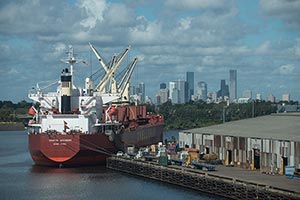Supersize Panama Canal Could Increase Houston's Direct Trade With Asia

Years of construction, delay and anticipation will crest on June 26 as the first containership officially traverses the expanded Panama Canal. While the Central American channel has not always been a significant trade route for the Port of Houston Authority, officials say the expansion could help boost its burgeoning trade with Asia.
"The fastest growing trade lane that we have right now is imports and exports to Asia," Port Authority executive director Roger Guenther said. "We've been looking forward to the expanded locks and the ability for larger ships to come through the Panama Canal for a long time."
A decade or so ago, the Port Authority didn't receive any containerships from Asia. Now three of its 18 weekly scheduled arrivals come from Asia via the Panama Canal. All are major carriers, and together they account for a significant chunk of the port's container's business. The most recent service began a few weeks ago.
"It's not the staple of what we do today," said Jeff Davis, chief port operations officer, "although we think in the future it can and will be."
The Port Authority doesn't know when one of the dramatically larger containerships that can now maneuver the Panama Canal will arrive in Houston, but it expects shipping line carriers with weekly services from Asia to consider using the larger vessels.
RELATED: Port of Houston Aims to be Distribution Hub for Center of Country
Bigger ships bring down the cost per container. In theory, the expanded canal's ability to receive such vessels could help the Port of Houston attract ships that have been docking along the West Coast and using railroads to ship goods inland. Sailing straight to Houston with more goods could become an affordable alternative.
Davis said the equivalent of 600,000 of those 20-foot containers come to Texas from the West Coast.
"It's an opportunity for us to seize that cargo," Davis said.
Houston's lower costs and more tranquil labor relations also could divert some cargo from the West Coast, agreed Patrick Jankowski, senior vice president of research for the Greater Houston Partnership. He sees another, lesser discussed positive impact of the canal's expansion: it could lower the cost of exporting plastics and chemicals to Asia.
This is especially relevant as Houston works to complete roughly $50 billion in petrochemical plant construction.
"It's going to go out as raw plastic, and it's going to come back as sneakers and soda straws," Jankowski said.
The industry's standard measurement for a containe ship's capacity is TEU, which refers to 20-foot-equivalent units or containers. Before its expansion, the Panama Canal could accommodate ships with 5,000-TEU capacity; it can now handle ships with up to 14,000 TEUs.
The Port Authority has spent hundreds of millions of dollars since the early 2000s to prepare for these leviathans, both those coming from Europe and also those that could traverse the Panama Canal. The Port Authority installed bigger cranes, reinforced docks and deepened and widened channels to its container terminals.
"The ship sizes in all trade lanes around the world, they're getting larger as people are looking to be able to ship cargo more efficiently," Guenther said.
The Port Authority has already handled ships capable of carrying 8,500 of the TEUs. These ships come from the east coast of South America and Northern Europe using routes that don't require the Panama Canal. The largest ship currently in its weekly service can handle 6,700 TEUs.
Guenther said he expects ships in the 8,500-TEU range will be the workhorse of the Gulf Coast for years to come. Getting the biggest ships will depend on market demand.
Todd Stewart, president of the Houston-based logistics company Gulf Winds International, expects the expanded canal to create an uptick in its work moving containers over time.
"Any time they get additional steamship services, that's more opportunity for shippers, importers and exporters," he said.
Other logistics companies, however, expect it to take a while before they feel any trickle-down benefit.
"Shippers and exporters have their routes already planned based on inventory demand in various locations," said Robert Murphy, owner of TXN Logistics. "They're not going to change it up until we see how the service runs."
If demand ultimately does attract the largest container vessels, the Houston Ship Channel's depth of 45 feet won't be sufficient, said David Egan, head of industrial and logistics research for CBRE in the Americas. CBRE is a commercial real estate services and investment firm.
"It does limit to some degree how much you can take advantage of what could come through the canal," he said.
That, for now, is a distant concern as 45 feet is ample for containerships moving the bulk of existing trade.

